Understanding Inventory Management
What do we mean by inventory management?
Inventory management is the process of ordering, handling, storing, and using a company’s non-capitalised assets – AKA its inventory. For some businesses, this involves raw materials and components, while others may only deal with finished stock items ready for sale.Either way, inventory management all comes down to balance – having the right amount of stock, in the right place, at the right time. And this guide will help you achieve just that.
What do we mean by inventory management?
Inventory management is the process of ordering, handling, storing, and using a company’s non-capitalised assets – AKA its inventory. For some businesses, this involves raw materials and components, while others may only deal with finished stock items ready for sale.
Either way, inventory management all comes down to balance – having the right amount of stock, in the right place, at the right time. And this guide will help you achieve just that.
Get the complete guide to Inventory ManagementDownload all 10 chapters of this inventory guide in one handy PDF – so you can easily upscale inventory management in your retail business.Download PDF
Retail inventory management
Retail is the general term used to describe businesses that sell physical products to consumers. While not exclusive to retail, inventory management tends to play more of a role in this industry than any other.
We’ll therefore be focusing mainly on inventory management from a retail perspective within this guide.
Retail can be split into several areas:
Offline. Where a company sells via a brick-and-mortar store or physical location.
Online. Where a company sells over the internet via an ecommerce website or marketplace.
Multichannel. Where a company sells in multiple different places, usually a combination of online websites and marketplaces.
Omnichannel. Where a company provides a unified, integrated experience for customers across all the different online and offline channels it sells on.
Businesses may also choose to trade via wholesale channels. This involves selling inventory (usually in bulk) directly business-to-business (B2B) or taking part in B2B ecommerce.
A company’s inventory will therefore need to be managed in accordance with which of these retail models it operates within.
Inventory management in action
We’ve covered the broad definition of inventory management. But what’s actually involved when it comes to making good inventory management happen?
Bottom line:
You want to keep inventory levels balanced at all times without ever having too much or too little of each product in stock.
This sounds simple, but rarely is. In reality, good inventory management all comes down to understanding:
Types of inventory. So you know what type of inventory is where and can have full visibility over it.
Inventory forecasting. So you know how much stock is needed to satisfy demand over an upcoming time period.
Purchasing inventory. So you know when and how to create purchase orders to re-order new stock.
Inventory storage. So you know how much of each inventory item can be suitably housed, and where to send it.
Inventory analysis. So you can use metrics to make more informed decisions about your inventory as time goes on.
Handling techniques. So you can quickly and efficiently book-in, put away, pick, pack and ship inventory as and when needed at your various locations.
Multichannel tracking. So you have visibility on where exactly your inventory is as well as additions (purchases) and subtractions (sales & shrinkage), to give as close to a live stock figure as possible.
Inventory accounting. So you can properly record your inventory on financial documents.
Inventory management systems. So you can automate as much of the inventory management process as possible.Choosing An Inventory Management System
These are the basic ingredients of quality inventory management. And you’ll need to take a systematic approach to them in order to best equip your business for long term growth.
Luckily, we expand on each of these points in depth within the different chapters of this guide.
What do we mean by inventory management?
Inventory management is the process of ordering, handling, storing, and using a company’s non-capitalised assets – AKA its inventory. For some businesses, this involves raw materials and components, while others may only deal with finished stock items ready for sale.
Either way, inventory management all comes down to balance – having the right amount of stock, in the right place, at the right time. And this guide will help you achieve just that.
Get the complete guide to Inventory ManagementDownload all 10 chapters of this inventory guide in one handy PDF – so you can easily upscale inventory management in your retail business.Download PDF
Retail inventory management
Retail is the general term used to describe businesses that sell physical products to consumers. While not exclusive to retail, inventory management tends to play more of a role in this industry than any other.
We’ll therefore be focusing mainly on inventory management from a retail perspective within this guide.
Retail can be split into several areas:
Offline. Where a company sells via a brick-and-mortar store or physical location.
Online. Where a company sells over the internet via an ecommerce website or marketplace.
Multichannel. Where a company sells in multiple different places, usually a combination of online websites and marketplaces.
Omnichannel. Where a company provides a unified, integrated experience for customers across all the different online and offline channels it sells on.
Businesses may also choose to trade via wholesale channels. This involves selling inventory (usually in bulk) directly business-to-business (B2B) or taking part in B2B ecommerce.
A company’s inventory will therefore need to be managed in accordance with which of these retail models it operates within.
Inventory management in action
We’ve covered the broad definition of inventory management. But what’s actually involved when it comes to making good inventory management happen?
Bottom line:
You want to keep inventory levels balanced at all times without ever having too much or too little of each product in stock.
This sounds simple, but rarely is. In reality, good inventory management all comes down to understanding:
Types of inventory. So you know what type of inventory is where and can have full visibility over it.
Inventory forecasting. So you know how much stock is needed to satisfy demand over an upcoming time period.
Purchasing inventory. So you know when and how to create purchase orders to re-order new stock.
Inventory storage. So you know how much of each inventory item can be suitably housed, and where to send it.
Inventory analysis. So you can use metrics to make more informed decisions about your inventory as time goes on.
Handling techniques. So you can quickly and efficiently book-in, put away, pick, pack and ship inventory as and when needed at your various locations.
Multichannel tracking. So you have visibility on where exactly your inventory is as well as additions (purchases) and subtractions (sales & shrinkage), to give as close to a live stock figure as possible.
Inventory accounting. So you can properly record your inventory on financial documents.
Inventory management systems. So you can automate as much of the inventory management process as possible.Choosing An Inventory Management System
These are the basic ingredients of quality inventory management. And you’ll need to take a systematic approach to them in order to best equip your business for long term growth.
Luckily, we expand on each of these points in depth within the different chapters of this guide.
The importance of inventory management
Good inventory management is a vital part of running a retail company. Without inventory, the business is worthless as it no longer has any stock to generate revenue from.
Good inventory management helps with providing a seamless customer experience, improving cash flow and maximizing profits, avoiding shrinkage and waste, and optimizing the fulfillment process. All making it an imperative task for serious retailers.
A retail business is useless without its inventory. And so while it may not be the most exciting subject, inventory management is vitally important to your business’s longevity.
Good inventory management helps with:
Customer experience. Not having enough stock to fulfill orders may cause overselling and ultimately unhappy customers.
Improving cash flow. Putting cash into too much inventory at once means it’s not available for other things – like payroll or marketing. Having a firm grip of your inventory levels is key to maintaining a good cashflow.
Avoiding shrinkage. Purchasing too much of the wrong inventory and/or not storing it correctly can lead to it becoming ‘dead’, spoiled, or stolen.
Optimising fulfilment. Inventory that’s put away and stored correctly can be picked, packed and shipped off to customers more quickly and easily.

What are the four types of inventory?
There are several different types of inventory a company might come across while handling and controlling its stock. The main ones being:
Raw materials.
Work-in-progress (WIP) inventory.
Finished goods.
Maintenance, repair & operations (MRO) goods.
We also include packing materials as a fifth type of inventory that an ecommerce retailer may need to keep track of.
How do you track inventory?
Inventory tracking can be done in a variety of ways, ranging from pen & paper, to online spreadsheet, to full blown inventory software. We cover each method in detail (including a spreadsheet template) in our dedicated chapter on inventory tracking.
The more sales channels you sell on (and the more sales you make on each one), the tougher this practice becomes. So most growing multichannel retail businesses will be looking at some form of automated system to take care of inventory tracking for them.
How do you manage inventory effectively?
The first step is to commit to regular and well-organized forecasting. You need to have a solid idea of exactly how much inventory you have on hand and plan to sell in an upcoming period, so you can plan for replenishment needs.
You’ll then need to purchase new inventory in a timely fashion, preferably based on specific reorder points. And also ensure you have the right organizational structure set up in your warehouse to allow for optimal storage, minimal shrinkage, and fast and systematic fulfillment.
A well set-up spreadsheet or automated system is essential to manage inventory across multiple sales channels. This way, you know exactly where inventory is, how much you have on-hand, and minimize the chances of over or under-selling what you have.
What are the methods of inventory management?
Methods are something we explore specifically in our chapter on inventory management techniques. But here are a few high-level examples of methods to control inventory:
Choose an appropriate fulfilment option.
Take forecasting seriously.
Set reorder points for each product.
Use EOQ for optimal order quantities.
Give each variant a dedicated warehouse bin.
Sell older inventory first.
Prioritise with ABC analysis.
Always track your metrics.
Verify accuracy with regular counts.
Automate as much as possible.
Key inventory management terms
Inventory management is a complex subject. And there’s a lot of systems, processes and general pieces that go into the puzzle.
Here’s a glossary of key terms you’re likely to come across:s
Average inventory | The average inventory on-hand over a given time period, calculated by adding Ending Inventory (EI) to Beginning Inventory (BI) and dividing by two. |
Average inventory cost | An inventory valuation method that bases its figure on the average cost of items throughout an accounting period. |
Back order (BO) | An order for a product that is currently out of stock, and so cannot yet be fulfilled for the customer. |
Barcode scanner | A device used to digitally identify items via a unique barcode, then perform inventory and fulfilment tasks like booking-in, picking, counts, etc. |
Beginning Inventory (BI) | The value of any unsold, on-hand inventory at the start of an accounting period. |
Bundles | A group of individual products in an inventory that are brought together to sell as one under a single SKU. |
Carrying costs | The total costs associated with holding and storing inventory in a warehouse or facility until it is sold on to the customer. |
Cost of goods sold (COGS) | Direct costs of purchasing and/or producing any goods sold, including everything that went into it – materials, labour, tools used, etc. Does NOT include indirect costs – like distribution, advertising, sales force costs, etc. |
Dead stock | Inventory that remains unsold for a long enough period of time for it to be deemed outdated and virtually unsellable. |
Ending Inventory (EI) | The value of any unsold, on-hand inventory at the end of an accounting period. |
First-in-first-out (FIFO) | An inventory valuation method that assumes stock that was purchased first, is also the first to be sold. |
Inventory count | Also known as a stock take, this is the systematic process of taking a physical count of inventory in order to verify accuracy. |
Inventory shrinkage | Inventory shrinkage is an accounting term to indicate inventory items that have been stolen, damaged beyond saleable repair or otherwise lost between the point of purchase and point of sale. |
Inventory valuation | The process of giving unsold inventory a monetary value in order to show as a company asset in financial records. |
Inventory variant | The variations of a single product that a company may hold in its inventory. For example, stocking a t-shirt in various colours and sizes. |
Inventory visibility | The ability of a person or business to see exactly where its inventory is and how it is being used. |
Last-in-first-out (LIFO) | An inventory valuation method that assumes the most recent products added to your inventory are the ones to be sold first. |
Lead time | The time it takes for a supplier to deliver new stock to the desired location once a purchase order has been issued. |
Multichannel | A retail model that sells in multiple different places, usually online via a combination of websites and marketplaces. |
Omnichannel | A retail model that goes beyond multichannel to integrate all of a company’s online and offline sales channels into one, unified customer experience. |
Order fulfilment | The process of getting a customer’s sales order from your warehouse or distribution centre to it being in their possession. |
Order management | The systematic order management process behind organising, managing and fulfilling all the sales orders coming into a business. From receiving orders and processing payment, right through to picking, packing, shipping, handling returns and communicating with customers. |
Overselling | Taking online orders for a product that turns out to be out of stock (usually through poor inventory management). Preventing overselling is key to providing a high-quality experience for online customers. |
Periodic inventory management | A type of inventory system that involves using manual processes to periodically count and update on-hand stock levels. |
A type of inventory system that involves automating your inventory tracking so it stays perpetually updated in real-time. | |
Pipeline inventory | Any inventory that has not yet reached its final destination of a company’s warehouse shelves, but is currently ‘en route’ somewhere within their supply chain – e.g. currently being manufactured, or being shipped by the supplier. |
Purchase order (PO) | A commercial document created by a business to its supplier, detailing quantities, items and agreed prices for new products to add to on-hand inventory. |
Sales order (SO) | A document created when a customer makes a purchase, detailing which products are to be received and how much has been paid or is owed. |
Stock-keeping unit (SKU) | A SKU is a unique alphanumeric code applied to each variant in a company’s inventory, helping to easily identify and organise a product catalogue. |
Supply chain | The complete flow a product or commodity takes from origin to consumer – including raw materials, to finished goods, wholesalers, warehouses and final destination. A retailer might only be directly responsible for certain chunks of this supply chain, but should still be aware of it in its entirety for the products they sell. |
Third-party logistics (3PL) | Refers to the use of an external third party to handle warehousing, inventory, fulfilment and/or customer service on behalf of a retail company. |
Key inventory management formulas
It’s not just common terminology you need to know when it comes to inventory management. There are some specific formulas to take note of too.
We’ll be going into greater depth with how and when to use these formulas later on in this guide. But here’s a quick run through to use as a reference point:
1) Inventory turnover
The inventory turnover ratio measures how many times your inventory is sold over a given time period. It’s, therefore, a critical analysis metric showing how effectively inventory is being managed overall.
The formula takes cost of goods sold (COGS) over a specific period, and divides it by average inventory over the same period.
Generally speaking, higher inventory turnover rates indicate better performance and efficiency. This is because the company would be getting through its inventory stocks more often – minimising carrying costs per unit.
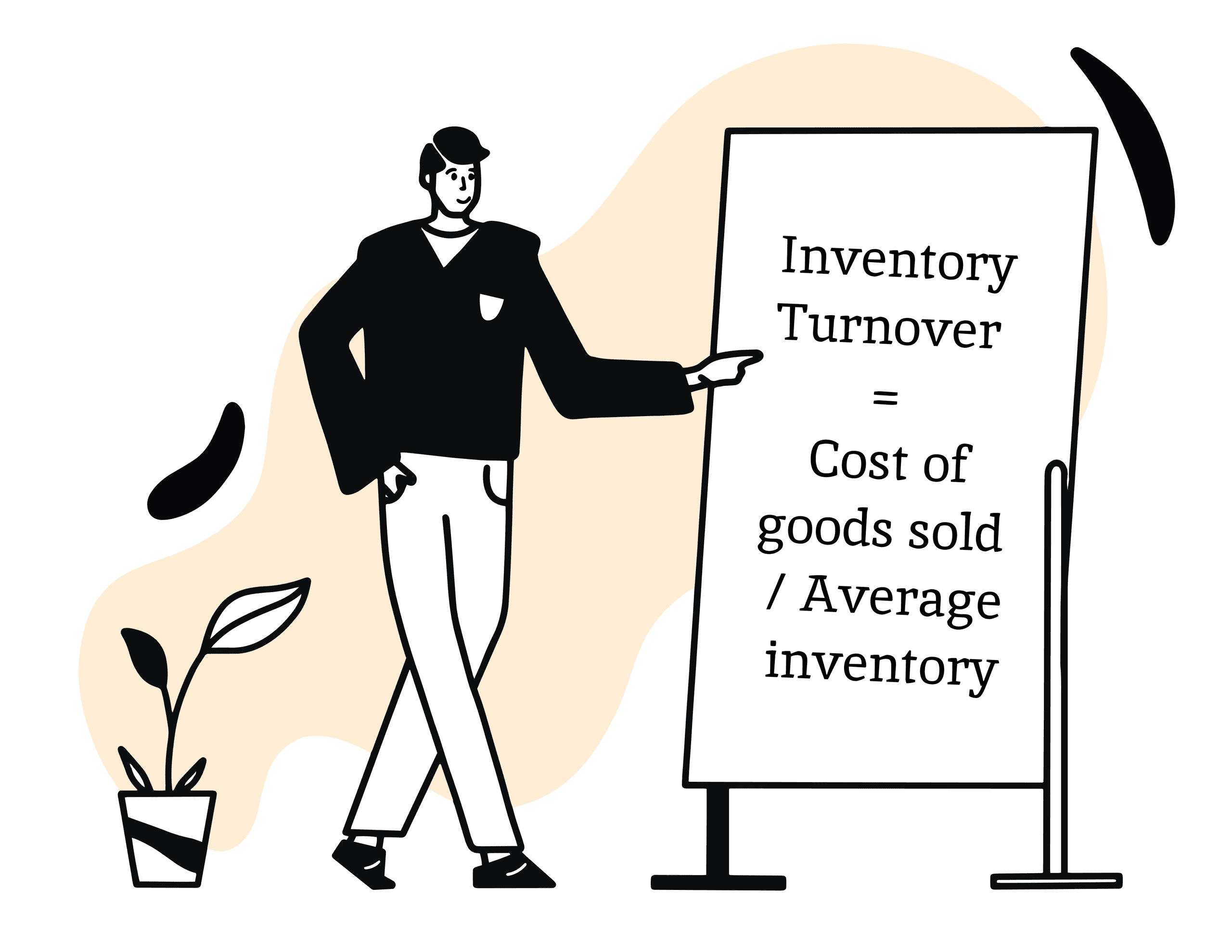
This gives an insight into the overall efficiency of a company and its inventory management processes. The higher the inventory turnover rate, the more efficient a business is at getting through its inventory.
INVENTORY TURNOVER CALCULATOR
Cost of Goods Sold÷Beginning Inventory+Ending Inventory2Enter your data above to calculate your results
2) Sell through rate
Sell through rate takes the amount of inventory a retailer receives, and compares it against what is actually sold over a given period. It’s usually expressed as a percentage:
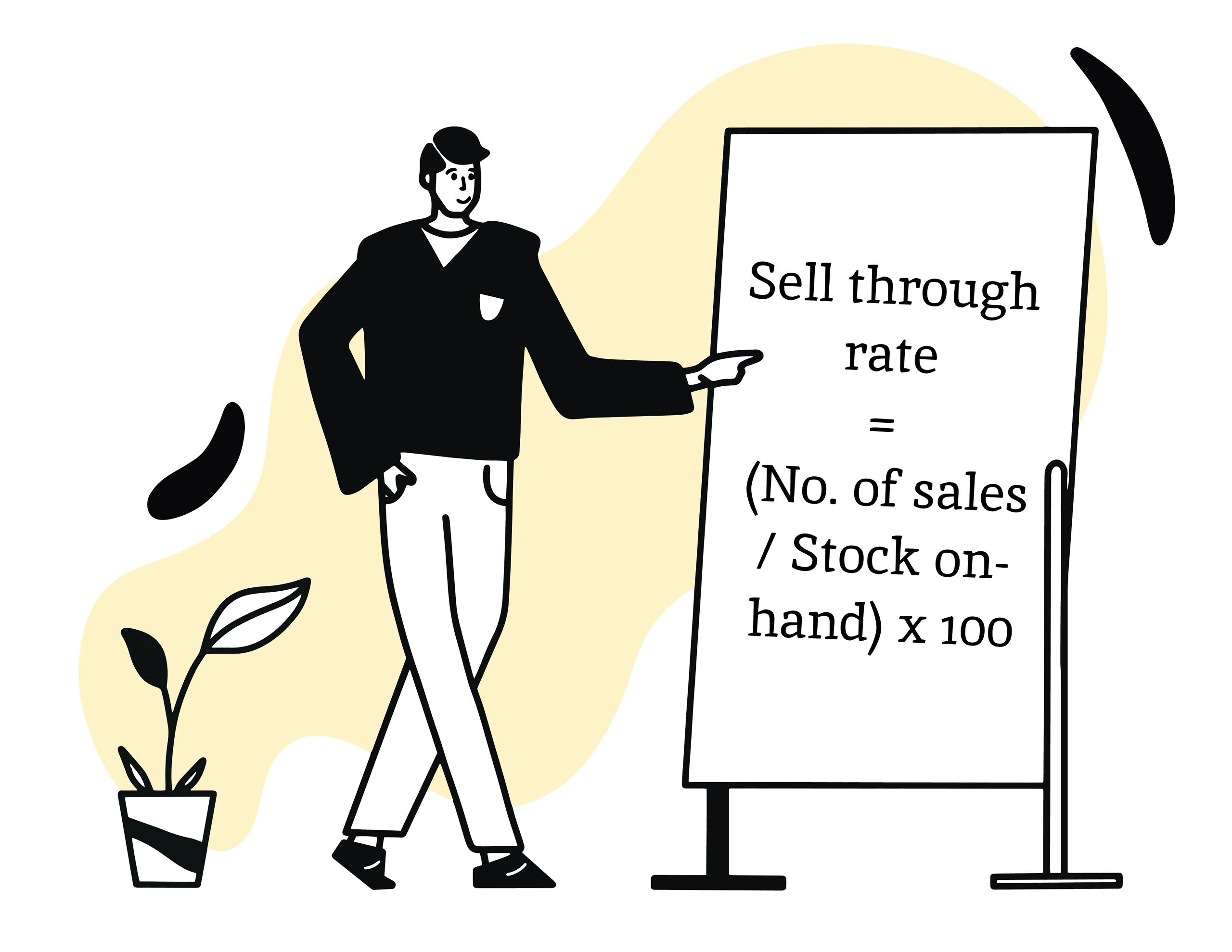
This helps analyse if your investment in a particular product is working out well. Low sell through rates indicate you either overbought or priced too high, while high sell through rates indicate you may have under bought or priced too low.
It’s a great way to make decisions on future purchase quantities for a product or from a particular supplier.
3) Days of inventory outstanding (DIO)
Days of inventory outstanding (DIO) measures the typical number of days it takes for inventory to turn into sales.
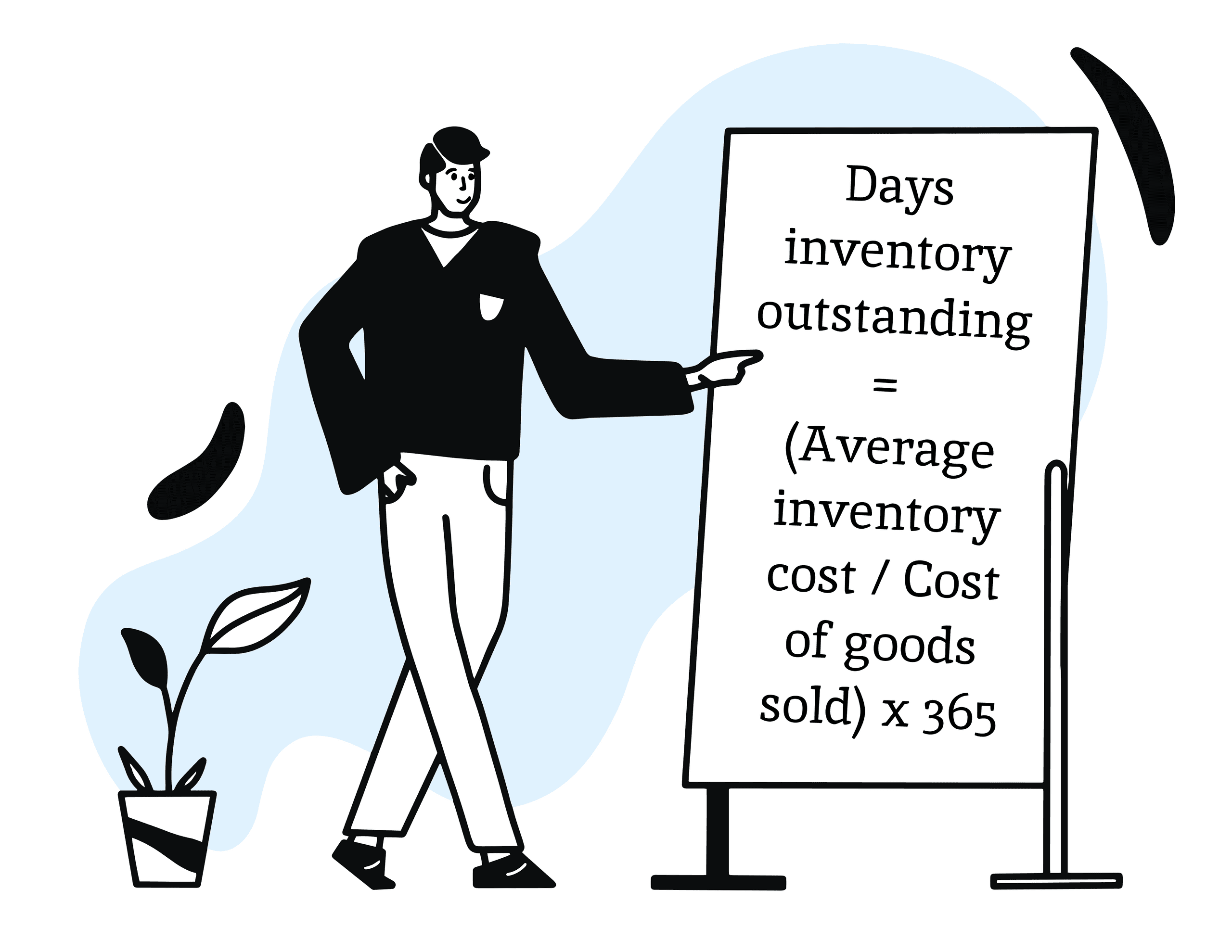
It’s hard to draw insights from just one calculation. But you should look into typical industry standards, and also keep track of whether you are trending up or down as time goes on.
4) Safety stock
Safety stock is the backup stock needed to meet unexpected supply problems and/or sudden changes in demand.
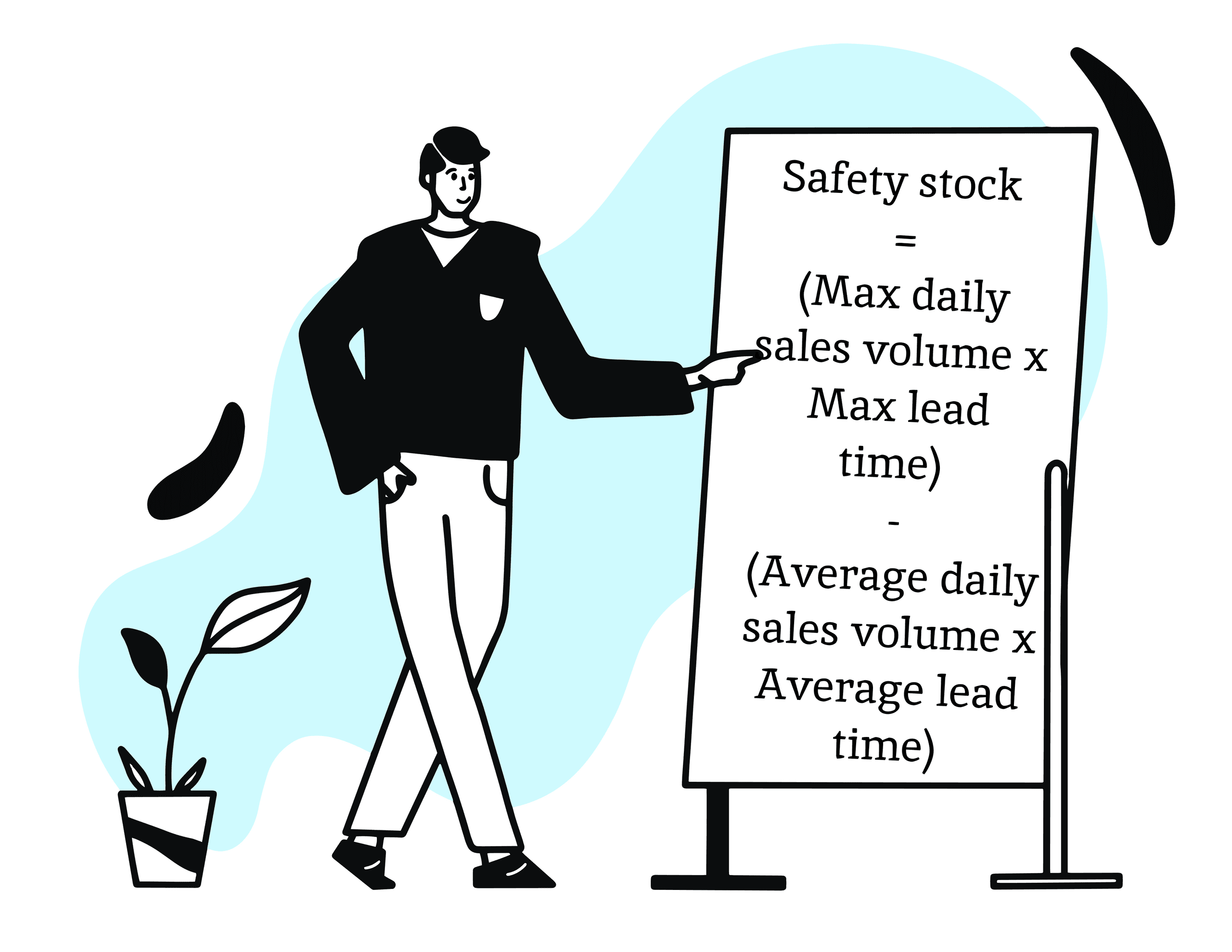
Bear in mind that you want to have enough safety stock to meet demand. But not so much that increased carrying costs puts a strain on cash flow.
5) Reorder point
The reorder point helps determine when to order new inventory. It is a specific point in time that acts as a trigger to re-order as soon as stock has diminished to that certain level.
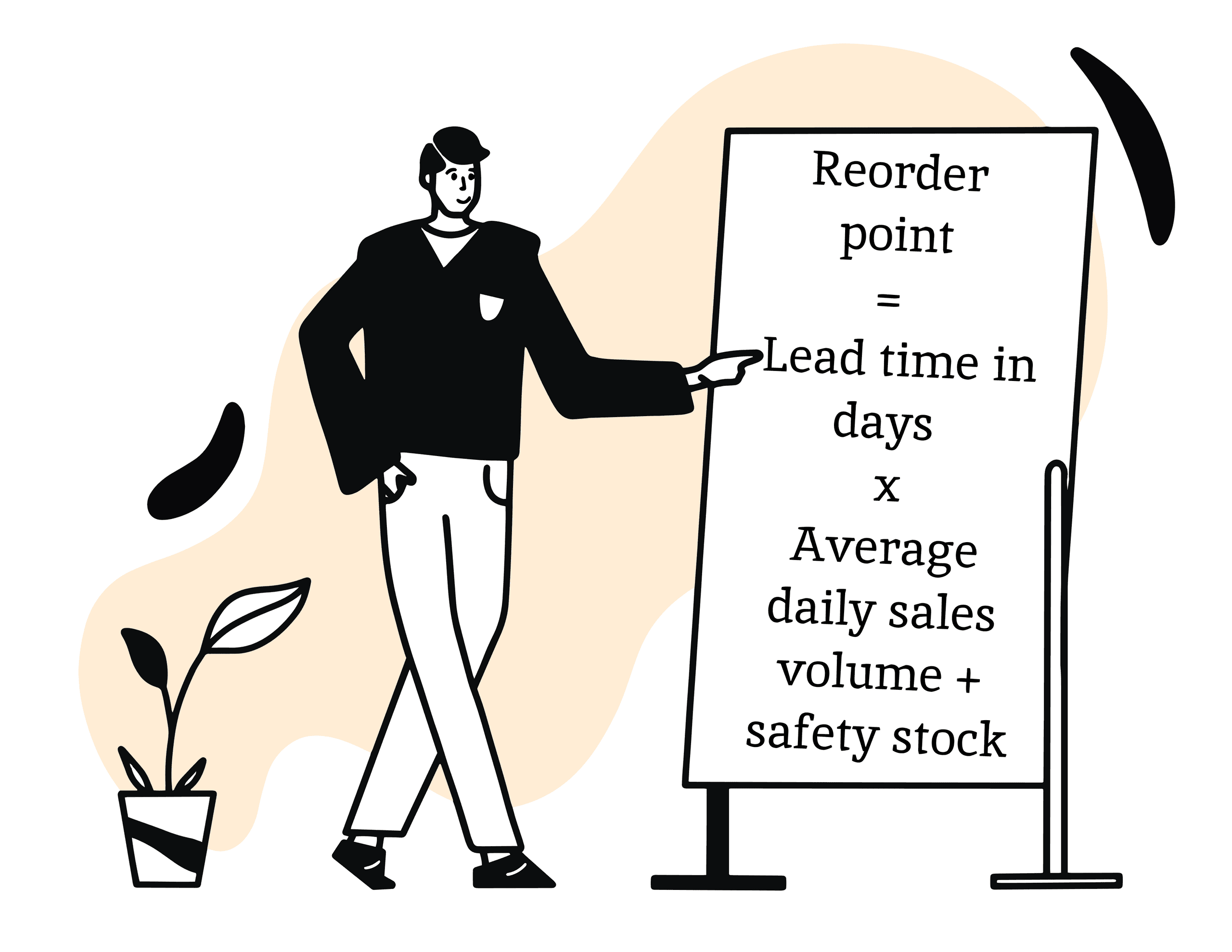
It’s important to consider the lead time for new stock to be delivered when setting reorder points. Enough stock should be leftover to keep up with demand before the newly purchased inventory becomes available for sale.
6) Economic order quantity (EOQ)
EOQ is a formula that helps calculate exactly how much inventory to order. It takes into account a company’s typical demand, ordering costs and carrying costs to provide the most economical figure possible:
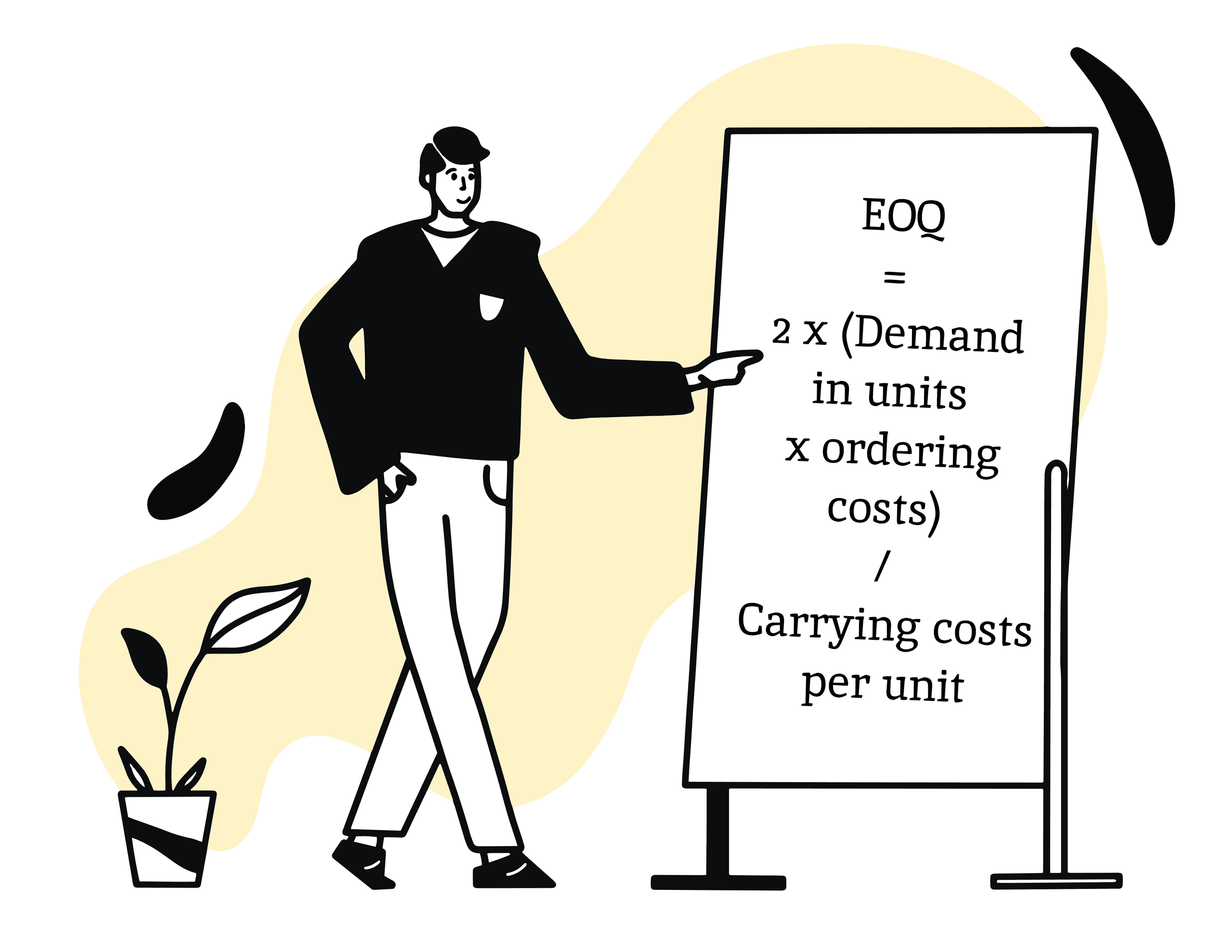
This is obviously quite a complicated formula to use. But we cover this in greater depth in Chapter 4: Purchasing Inventory.
Inventory management software
An inventory management software or system does all the heavy lifting for a retail business when it comes to its inventory. It tracks inventory additions and subtractions automatically, without relying on manual, paper or spreadsheet processes.

Systems like this are becoming more and more popular among growing businesses as they tackle the challenges of modern multichannel and omnichannel retail.
Choosing an inventory management system that’s right for your business can be a tricky process. But here are a few pillar features of good software:
Real-time tracking. Syncs a live inventory figure across all sales channels and warehouses.
Forecasting. Uses past sales data to project estimated inventory requirements into the future.
Purchasing. Helps manage all suppliers and purchase orders for quick and easy stock replenishment.
Rules & automations. Allows creation of inventory rules, e.g. to dictate how much stock shows on each sales channel.
Cloud-based. Accessed from anywhere with data never being overwritten by team members making changes.
Many systems (like Veeqo) will also help manage and automate a plethora of other operational tasks – like sales & wholesale orders, picking & packing, shipping, and returns.





